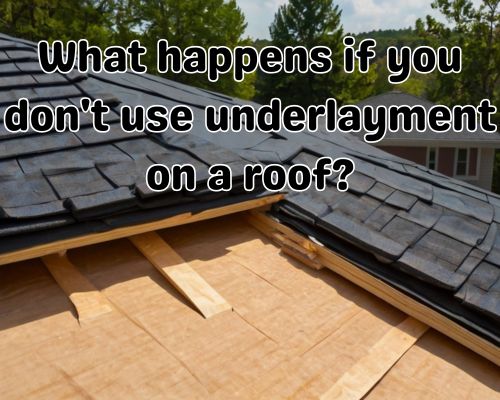When it comes to roofing in West Palm Beach, Florida, skipping underlayment might seem like a shortcut—but it’s a gamble that can lead to costly consequences. Florida’s unique subtropical climate presents roofing challenges that are not only seasonal but structural. This makes understanding the role of roofing underlayment absolutely essential.

With Star Roofing, we’ll break down what happens if you don’t use underlayment on a roof, especially under West Palm Beach’s intense sun, storms, and humidity. From moisture barriers and wind mitigation to warranty voids and building code compliance, we’ll uncover what’s at stake when you skip this crucial layer.
Understanding Roofing Underlayment: The Invisible Shield
Before diving into the consequences, let’s clarify what roofing underlayment is. It’s the layer installed directly on the roof deck, beneath the shingles, tiles, or metal panels. In West Palm Beach, the most common types are:
- Asphalt-saturated felt (felt paper)
- Synthetic underlayment
- Rubberized asphalt (peel-and-stick)
Each serves as a secondary moisture barrier, protecting your home if the top roofing layer fails or is damaged.
What Happens If You Don’t Use Underlayment?
Skipping underlayment might reduce installation costs upfront, but the risks far outweigh the savings—especially in a coastal area like West Palm Beach. Let’s break it down.
1. Moisture Intrusion & Water Damage
Without underlayment, your roof has no backup layer to block moisture. West Palm Beach sees over 60 inches of rainfall annually. That’s a lot of potential water seeping beneath shingles during storms or hurricanes. Without this shield:
- Roof leaks become more likely
- Wood rot in roof decking and rafters accelerates
- Mold and mildew infestations can spread into attic spaces
In Florida’s humid climate, moisture issues can spiral into full-blown health hazards and structural degradation in record time.
2. Reduced Roof Lifespan
The lifespan of roofing materials in West Palm Beach is already tested by high UV exposure and salt-laden air from the Atlantic. Underlayment helps extend a roof’s durability by:
- Minimizing thermal expansion and contraction
- Reducing shingle uplift during high winds
- Shielding the decking from intense UV radiation
Without this layer, roofing systems in South Florida typically degrade 10-20% faster, especially asphalt shingles.
3. Void Warranty Coverage
Most roofing manufacturers (like GAF, Owens Corning, and CertainTeed) require underlayment as part of their installation specifications. If your contractor skips it, you risk voiding the manufacturer’s warranty.
If a hurricane rolls through West Palm Beach and damages your roof, you might find your warranty claims denied—all because of a missing layer beneath the surface.
4. Building Code Violations in Palm Beach County
Here’s a kicker—Florida Building Code (FBC) mandates roofing underlayment for nearly all roofing systems. In Palm Beach County, code compliance is strict due to frequent tropical storms and hurricanes.
Omitting underlayment can result in:
- Failed inspections
- Fines or penalties
- Delays in issuing Certificates of Occupancy (COs)
- Insurance claim denials
Don’t be surprised if a future buyer’s home inspector flags it, torpedoing your real estate deal.
5. Vulnerability During Roof Installation
Roofing projects often span several days. During that time, underlayment provides temporary protection in case of sudden rainfall—common in West Palm Beach’s unpredictable weather patterns.
No underlayment? A surprise afternoon thunderstorm can soak your roof decking, causing damage before shingles are even installed.
Local Case Study: Hurricane Ian’s Wake in Palm Beach County
Post-Hurricane Ian inspections in 2022 revealed that roofs without proper underlayment suffered more severe damage than those that followed Florida code requirements. Homes with peel-and-stick or double-layer underlayment held up significantly better—even when shingles were blown away.
Roofers in West Palm Beach noted that many emergency repair calls came from properties that cut corners on moisture barriers during initial installs.
The Role of Roofing Contractors in West Palm Beach
Local roofing companies in West Palm Beach—like Sunshine Roofing, Palm Beach Prestige Roofing, and Coastal Elite Contractors—understand that weather-resilient roofing systems aren’t optional here; they’re essential. These pros use high-quality underlayment designed for Florida’s high-humidity, high-wind, and high-UV exposure.
When hiring a contractor, always verify that their roof replacement or new construction plan includes the correct underlayment type for your home’s needs.
Insurance & Underlayment: What West Palm Beach Homeowners Must Know
Your homeowners insurance policy may be affected if you skip underlayment. Many insurers in Florida require proof of compliant installation methods to approve claims—especially for windstorm or flood events.
And don’t forget, citizens insurance audits are becoming more common in South Florida. You don’t want your roof deemed non-compliant because someone decided to save a few bucks on materials.
Final Thoughts: Cutting Corners Can Cost You Big in West Palm Beach
So, what happens if you don’t use underlayment on a roof? In a climate like West Palm Beach, the answer is simple: You compromise your home’s integrity, safety, and value.
From legal and financial risks to structural and environmental hazards, omitting underlayment is a short-term decision with long-term regrets.
Don’t leave your home’s defense against Florida’s intense climate up to chance. Ensure your roofing system includes underlayment that meets or exceeds Palm Beach County code requirements.
Call to Action: Don’t Wait Until It Leaks
If you’re considering a roof replacement in West Palm Beach, or unsure if your current roof includes underlayment, schedule an inspection with a licensed roofing contractor today. Make sure your roof is storm-ready, code-compliant, and built to last.